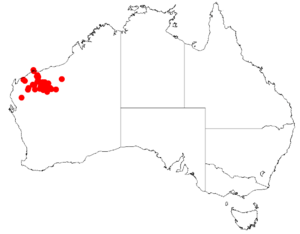Scaevola acacioides facts for kids
Quick facts for kids Scaevola acacioides |
|
|---|---|
| Scientific classification | |
| Genus: |
Scaevola (plant)
|
| Species: |
acacioides
|
 |
|
| Occurrence data from Australasian Virtual Herbarium | |
Scaevola acacioides is a type of plant that grows as a bush. It's part of the Goodeniaceae family. This plant stands upright and can spread out.
Contents
What Does Scaevola acacioides Look Like?
Scaevola acacioides is a shrub that can grow from about 0.6 to 2 meters (2 to 6.5 feet) tall. Its stems are smooth and don't have any ridges.
Leaves and Flowers
The leaves are thick and grey-green. They don't have stalks, meaning they attach directly to the stem. Each leaf is long and narrow, shaped like an oval. They are usually 25–50 millimeters (1–2 inches) long and 2–5 millimeters (0.08–0.2 inches) wide. The edges of the leaves are smooth.
The flowers can grow in different ways. They might appear in branched clusters or as single flowers where the leaves meet the stem. The main part of the flower, called the corolla, is white. It measures about 15–22 millimeters (0.6–0.9 inches) long. The outside of the flower can be either smooth or slightly hairy. Inside, it has a few star-shaped hairs.
Inside the Flower
The parts of the flower that hold pollen, called anthers, are separate. A special cup-like part that covers the stigma (the part that receives pollen) is hairy. The part of the flower that develops into the fruit, called the ovary, sits below the other flower parts. It is not swollen at the base. The style, which connects the stigma to the ovary, is hairy and about 11–12 millimeters (0.4–0.5 inches) long.
Fruit and Flowering Time
The fruit of Scaevola acacioides is black and shaped like an egg. It is smooth and grows up to 5 millimeters (0.2 inches) long. Each fruit usually contains one or two seeds. This plant typically flowers in March, April, May, and August.
The way its flowers branch out and its long, narrow leaves help tell this species apart from other plants in the Scaevola group.
Where Does Scaevola acacioides Grow?
Scaevola acacioides is found only in Western Australia. It grows in specific areas known as the Carnarvon, Gascoyne, and Pilbara regions. You can find it in rocky, gravelly, or sandy red soils.
How Was It Named?
Scientific Discovery
The plant Scaevola acacioides was first officially described in 1990. This was done by a scientist named Roger Charles Carolin. He wrote about it in a science journal called Telopea.
A special plant sample, called a holotype, was collected on May 30, 1966. This sample, which helps scientists identify the species, was found by J.V. Blockley at Bee Gorge, near Wittenoom.
Meaning of the Name
The name Scaevola comes from Latin. It means "left-handed" and refers to an ancient Roman hero named Gaius Mucius Scaevola. The flower's shape reminded people of a hand.
The second part of the name, acacioides, tells us something else. It comes from the plant name Acacia and the Greek word -oides, which means "resemblance" or "like." So, acacioides means "Acacia-like," suggesting it looks similar to Acacia plants in some way.

